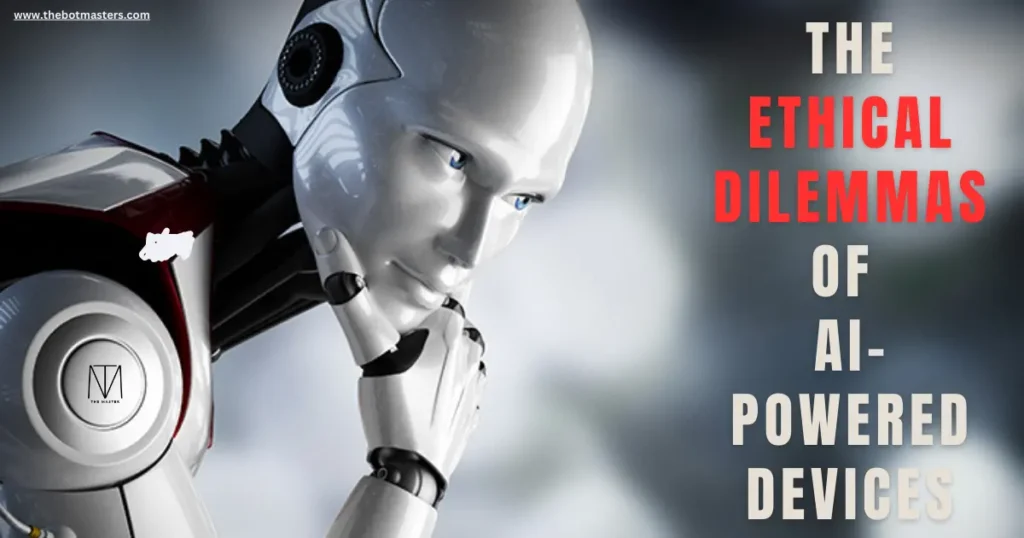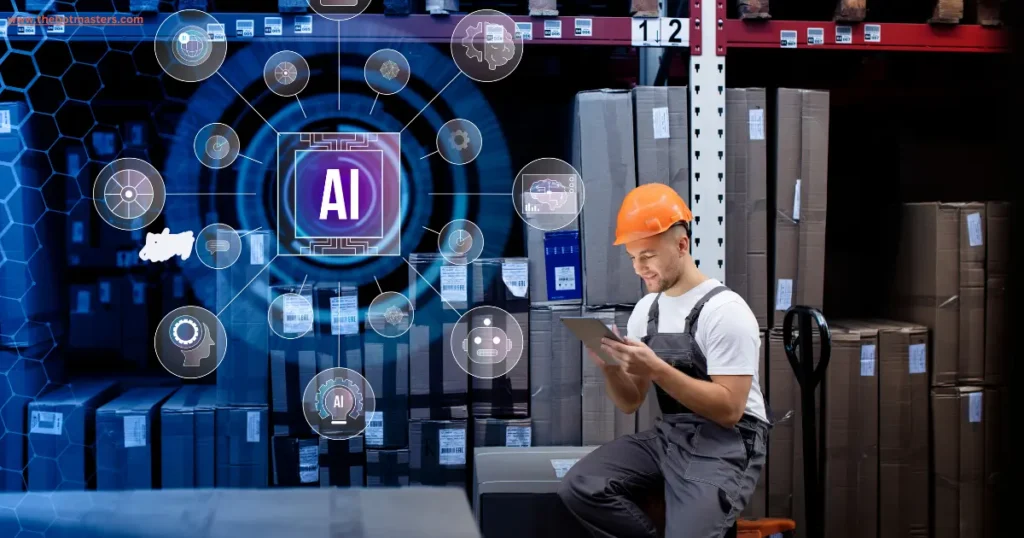The rapid proliferation of AI-powered devices has reshaped the way we live and interact with technology. These devices, equipped with artificial intelligence, have found their way into our homes, workplaces, and even our pockets. While they promise convenience and efficiency, they also bring with them a host of ethical dilemmas that society must grapple with. In this blog post, we will explore the ethical dilemmas of AI-powered devices in our daily lives.

Introduction
AI-powered devices, from smart speakers like Amazon’s Alexa to autonomous vehicles and predictive algorithms, are becoming an integral part of our daily lives. These technologies aim to make our lives easier, safer, and more connected, but they also raise important ethical questions that cannot be ignored. To dive into these dilemmas, we will explore several key areas.
I. Privacy Concerns
A. Data Collection
One of the primary concerns surrounding AI-powered devices is the extent of data they collect. These devices often record conversations, monitor user behavior, and gather personal information. The sheer volume of data raises questions about who has access to it and for what purpose.
- The Extent of Data Collected: Consider the case of smart home devices like security cameras and thermostats. They collect data on your daily routines, which can be highly invasive when in the wrong hands.
- Invasive Surveillance: The potential for invasive surveillance is evident, raising concerns about the erosion of personal privacy. These devices can record, store, and analyze data without our consent, making us susceptible to unwarranted intrusion.
B. Consent and Transparency
AI devices often operate without users fully understanding the extent of data collection or the consequences of their usage. Ensuring transparency and obtaining informed consent is a crucial aspect of addressing these privacy concerns.
- User Awareness and Informed Consent: Users should be aware of what data is being collected and how it will be used. Lack of transparency can lead to data misuse and harm.
- The Role of Privacy Policies: Clear and comprehensive privacy policies can help users make informed decisions about using AI-powered devices.
II. Bias and Discrimination
A. Algorithmic Bias
Bias in AI systems is a growing concern. AI algorithms learn from historical data, and if that data is biased, the AI can perpetuate and even exacerbate these biases.
- The Problem of Biased Training Data: If AI systems are trained on data that reflects societal biases, they may make biased predictions or decisions.
- Impact on Marginalized Communities: Algorithmic bias can disproportionately affect marginalized groups in areas like criminal justice, housing, and employment, perpetuating existing inequalities.
B. Discriminatory Outcomes
The real-world consequences of algorithmic bias are troubling. They can result in unfair treatment, often in high-stakes domains.
- Employment and Financial Services: AI-powered hiring tools and financial algorithms have been found to favor certain demographics, potentially denying opportunities to others.
- Criminal Justice System: Predictive policing and risk assessment algorithms can lead to unfair profiling and sentencing, impacting individuals’ lives profoundly

III. Autonomy and Accountability
A. Human-Machine Interaction
The rise of AI-powered devices raises questions about who holds control. Do these devices enhance our autonomy, or do they make decisions on our behalf?
- Control Over AI-Powered Devices: It’s crucial to maintain user control over AI devices, ensuring they enhance human capabilities rather than diminishing them.
- The Impact on Decision-Making: When AI systems make decisions, it can lead to the loss of accountability, especially in critical situations.
B. Liability and Responsibility
Determining accountability when AI systems go wrong is challenging. Legal and moral responsibilities must be clarified.
- Legal and Moral Accountability: It’s not clear who is responsible when an AI-powered device makes a wrong decision or causes harm. This lack of accountability can hinder progress in AI adoption.
- Challenges in Assigning Blame: When multiple parties, including developers, users, and AI itself, are involved, assigning blame becomes a complex task.
IV. Job Displacement
A. Automation and Employment
AI’s ability to automate tasks has led to fears of job displacement, particularly in industries that rely on routine tasks.
- Job Loss Due to AI-Powered Automation: While automation can improve efficiency, it can also lead to job loss, leaving many workers at risk.
- The Need for Reskilling and Upskilling: To mitigate job displacement, investments in reskilling and upskilling programs are essential to prepare the workforce for the future.
B. Economic and Social Impacts
Job displacement has broader economic and social implications that extend beyond unemployment rates.
- Income Inequality and Job Instability: Automation can exacerbate income inequality and result in job instability for many workers.
- Potential for Socioeconomic Disruption: If not managed properly, AI-driven job displacement could lead to social disruption and unrest.
V. Security Risks
A. Hacking and Malicious Use
AI systems, when connected to the internet, can be vulnerable to hacking and malicious use.
- Vulnerabilities in AI-Powered Systems: Weaknesses in AI systems can be exploited, leading to data breaches, identity theft, and other security threats.
- Potential for Cyberattacks and Misuse: AI-powered devices can become tools for cybercriminals if not adequately secured.
B. Autonomous Weapons
The creation and use of autonomous weapons present complex ethical problems.
- The Ethical Dilemma of AI in Warfare: The use of AI in military operations has raised questions about the morality of autonomous weapons.
- Calls for Regulations and Bans: There is a growing call for international regulations and bans to prevent the development and use of autonomous lethal weapons.

VI. Ethical Design and Development
A. Ethical AI Principles
Embedding ethical principles in AI design and development is essential for creating responsible technology.
- Implementing Ethical Guidelines: Companies and developers should adhere to ethical guidelines that prioritize fairness, transparency, and accountability.
- Ethical Considerations During AI Development: The ethical implications of AI should be considered at every stage of development, from data collection to deployment.
B. Ethical Training Data
The quality and fairness of training data are crucial to reducing bias in AI systems.
- Ensuring Fairness and Inclusivity in Data Collection: Efforts should be made to ensure that training data is diverse and representative of all demographics.
- Addressing Biases at the Source: Addressing bias during data collection and labeling can help reduce the bias in AI outcomes.
VII. Regulatory and Legal Frameworks
A. The Need for Regulation
Governments and international bodies must establish regulatory frameworks to guide the responsible development and use of AI.
- The Role of Governments and International Bodies: A coordinated effort is needed to regulate AI technologies while fostering innovation.
- Balancing Innovation with Safeguards: Striking a balance between innovation and ethical safeguards is challenging but crucial.
B. Ethical Oversight
Establishing ethical review boards and auditing mechanisms can help ensure compliance with ethical standards.
- Ethical Review Boards: Independent boards can assess the ethical implications of AI technologies and offer guidance.
- Enforcing Ethical Standards: Mechanisms must be in place to enforce ethical standards, ensuring that companies and developers adhere to them.
Conclusion
The proliferation of AI-powered devices has brought both promise and peril to our lives. While they offer immense convenience and efficiency, they also raise significant ethical dilemmas. These dilemmas encompass privacy, bias and discrimination, autonomy, job displacement, security risks, ethical design, and the need for robust regulatory frameworks. Addressing these issues is imperative to ensure that AI technologies are developed and used responsibly, ultimately benefiting society as a whole. The path forward lies in a collaborative effort from all stakeholders – governments, tech companies, developers, and users – to strike a balance between technological advancement and ethical responsibility.
Frequently Asked Questions (FAQs)
AI-powered devices are technologies that utilize artificial intelligence, such as smart speakers, autonomous vehicles, and predictive algorithms, to perform tasks, make decisions, and interact with users.
Ethical dilemmas in AI devices are significant because they affect privacy, fairness, accountability, and societal well-being. Addressing these issues is crucial to ensure responsible development and use of AI technologies.
Privacy concerns include extensive data collection, invasive surveillance, lack of user consent, and transparency issues related to how data is used and shared
AI-powered devices can perpetuate biases present in their training data, leading to discriminatory outcomes in areas like employment, financial services, and criminal justice
Yes, some AI devices can make autonomous decisions, which raises questions about control and accountability in human-machine interactions.
Job displacement due to AI automation can lead to unemployment, income inequality, and social disruption. It necessitates efforts in reskilling and upskilling the workforce.
AI devices connected to the internet can be vulnerable to hacking, leading to data breaches and identity theft. Additionally, there is a concern about the use of AI in autonomous weapons for military purposes
Ethical development requires implementing ethical guidelines, addressing bias in training data, and considering ethical implications throughout the development process.
Regulations are essential to establish ethical standards, ensuring responsible AI development, and holding developers and companies accountable for their actions
Individuals can protect their privacy by understanding the data collection practices of AI devices, reviewing privacy policies, and regularly updating security features on these devices.
Yes, international efforts, such as discussions on AI ethics and the development of frameworks like the EU’s Artificial Intelligence Act, are underway to regulate AI technology at a global level
Read More…
The Transformative Power of AI in Entertainment
AI Tools in Finance: Revolutionizing the Financial World
AI Language Translation Devices for Travelers
AI Tools in Education: Transforming the Future of Learning
Supercharge Your Productivity with AI Gadgets
AI Tools for Marketers: Revolutionizing the Way You Reach Your Audience
AI in Healthcare: 7 Key Innovations Transforming Medicine
AI Tools for Businesses: Enhancing Efficiency and Growth
The Future of Technology: Exploring Wearable AI Tech
Exploring the World of Smart Home Devices: A Comprehensive Guide
An Introduction to AI Tools: Unlocking the Power of Artificial Intelligence
How to Guide for Important AI Tools
“Discover AI Tools on Amazon”
If you’re interested in exploring AI Translation devices, you can find a wide range of options on Amazon. From smart devices to data analytics software, Amazon offers a selection of AI solutions that can help your business thrive. Explore AI tools on Amazon today to stay ahead in the digital age.
Please note that if you decide to make a purchase through this link, I may earn a small commission at no additional cost to you.
“Thank you for your support!”
